알라딘: 선의 나침반
선의 나침반 - 숭산 대선사의 가르침


숭산 (지은이),현각 (엮은이),허문명 (옮긴이)김영사2010-05-05

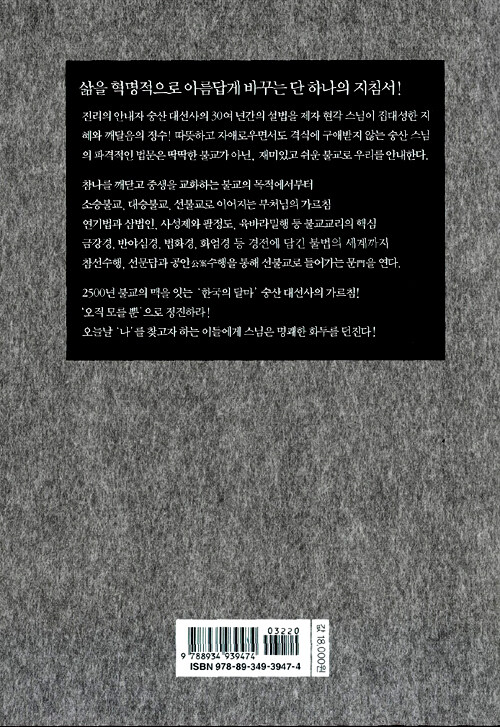


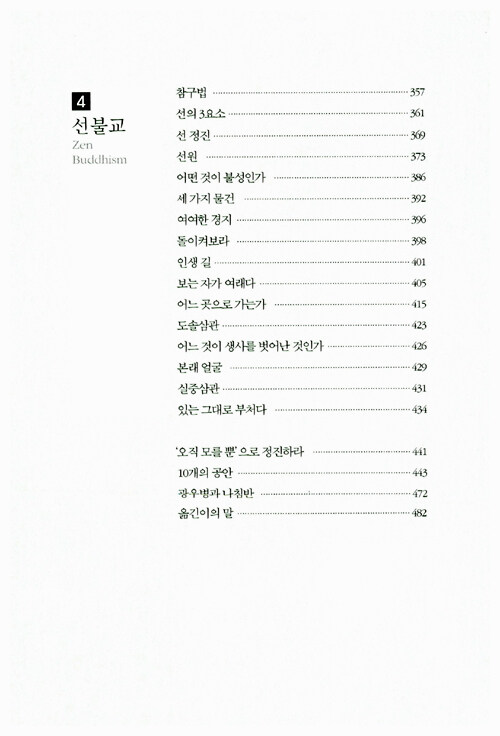

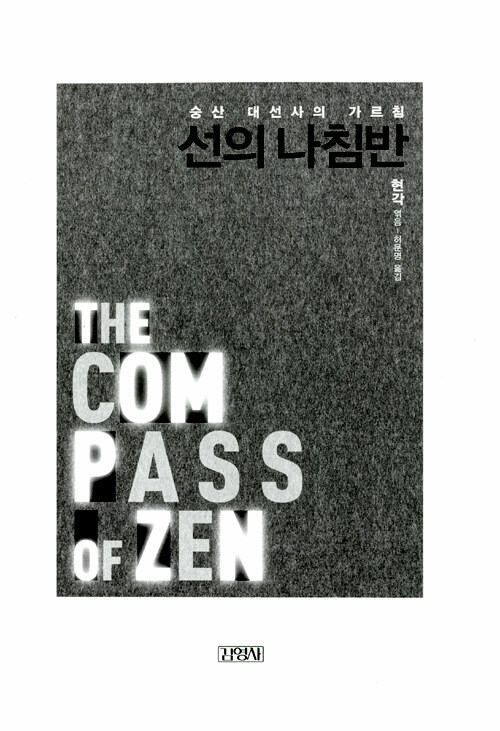

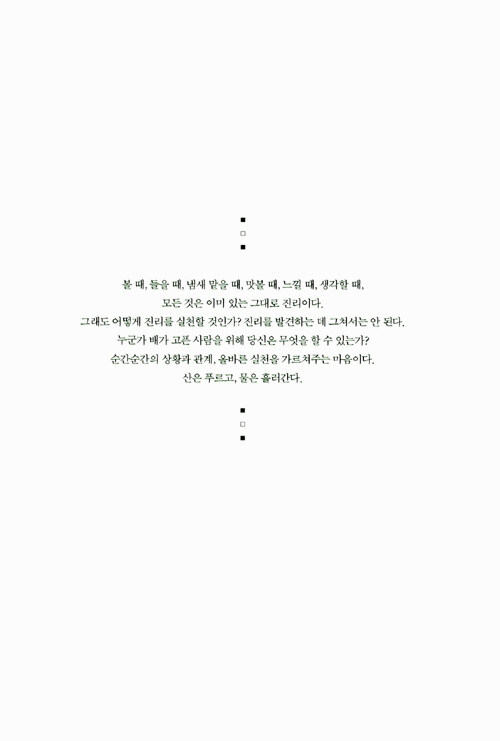

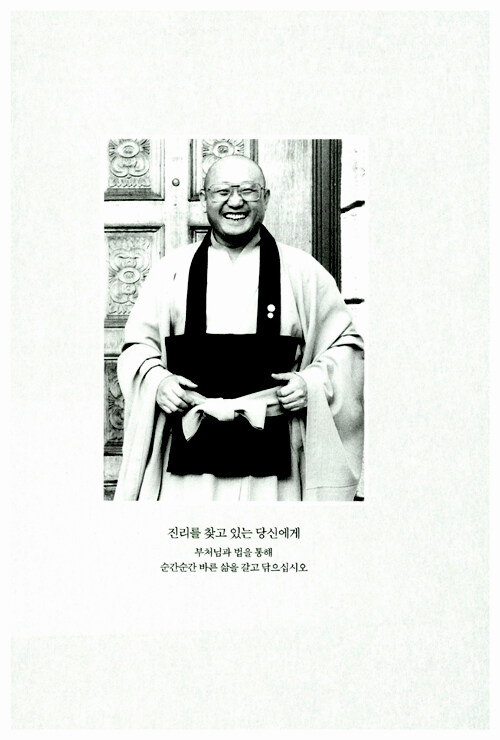

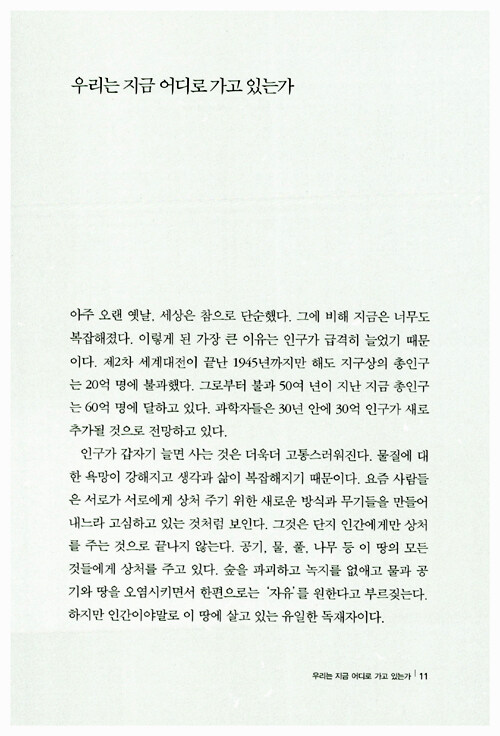

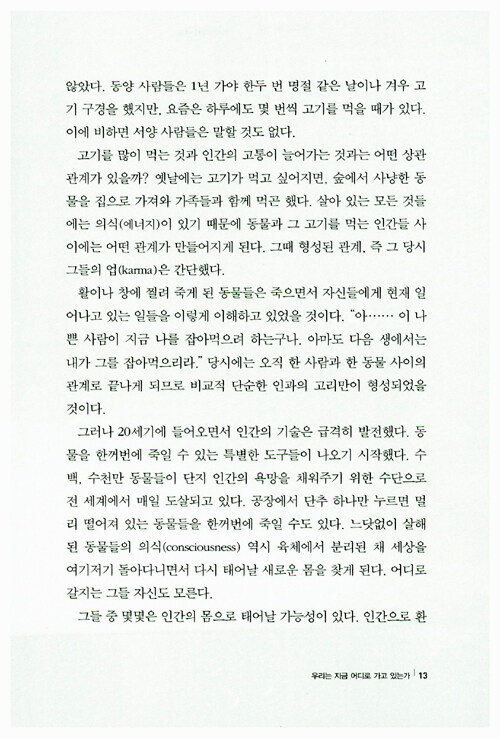
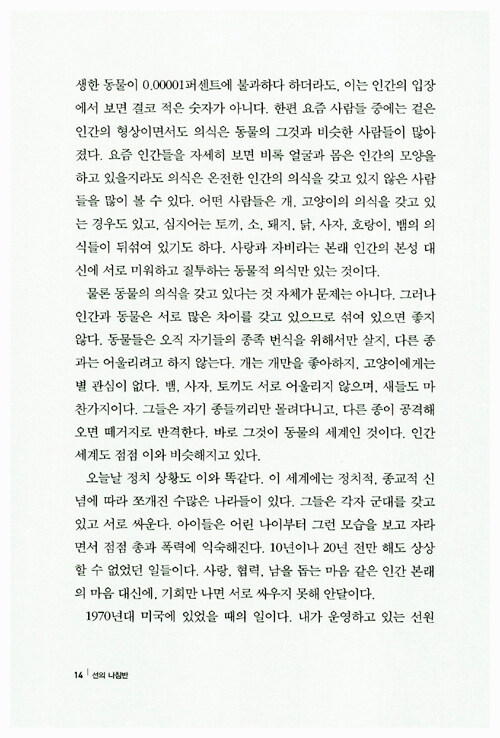

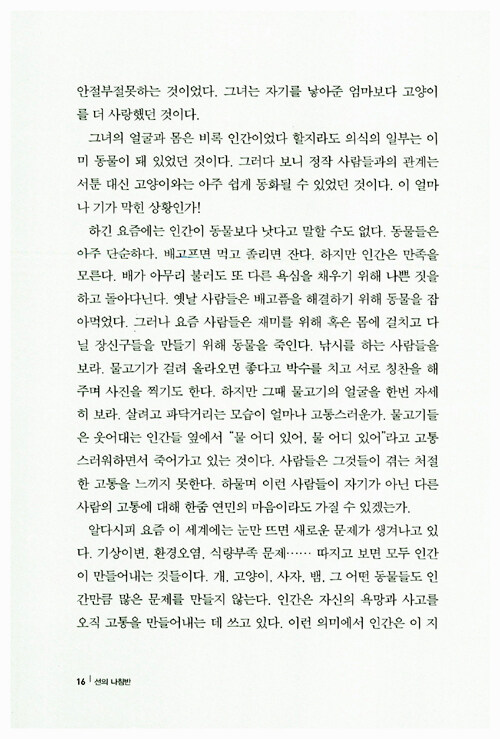
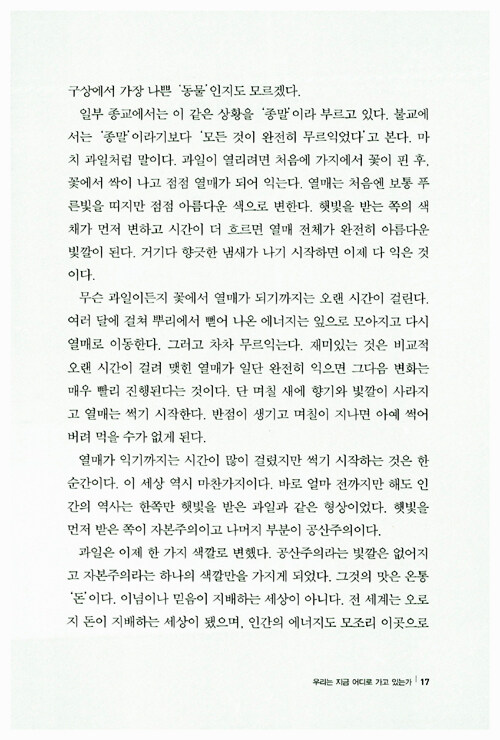

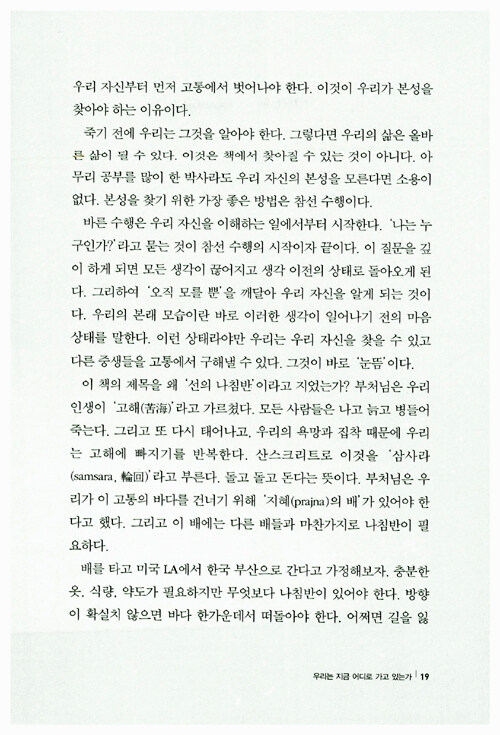

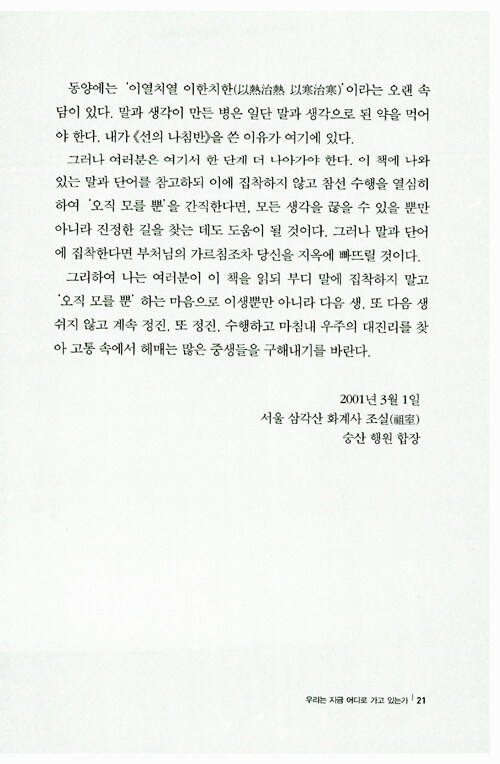

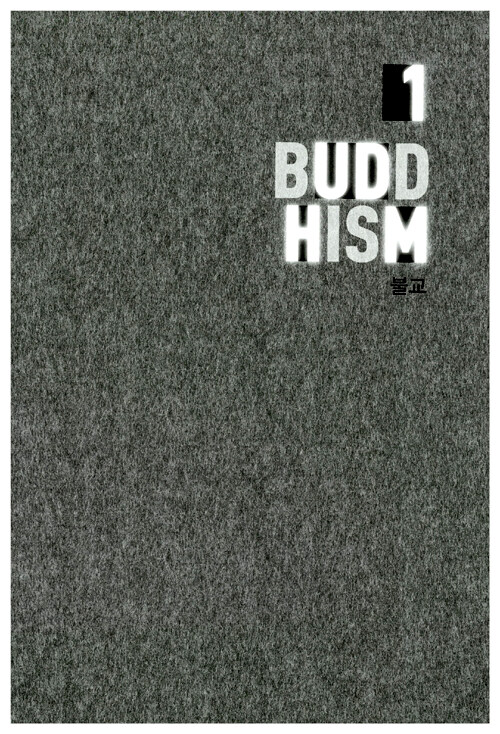


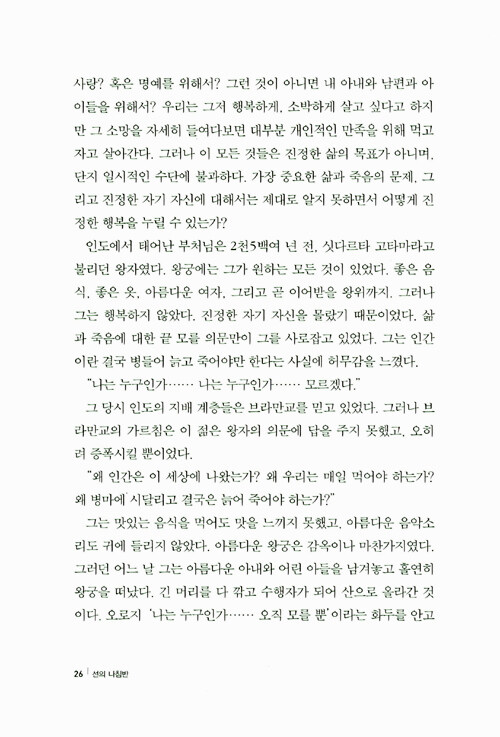
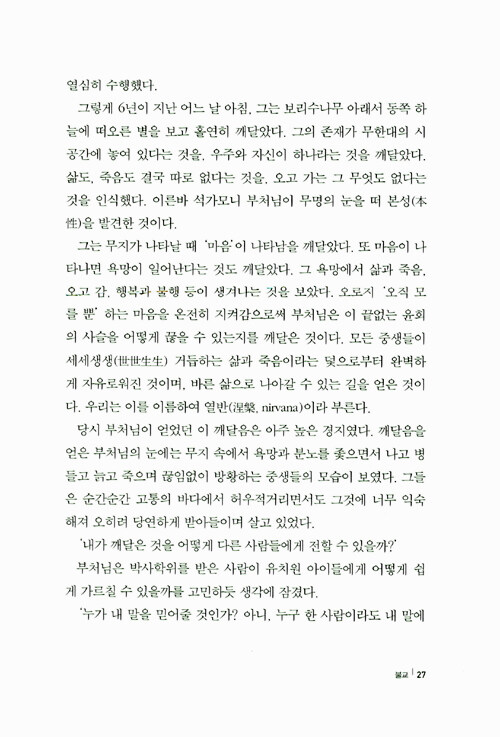

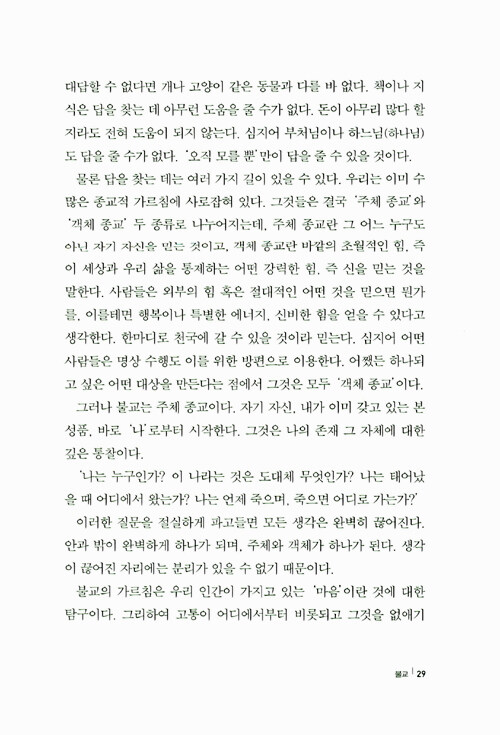
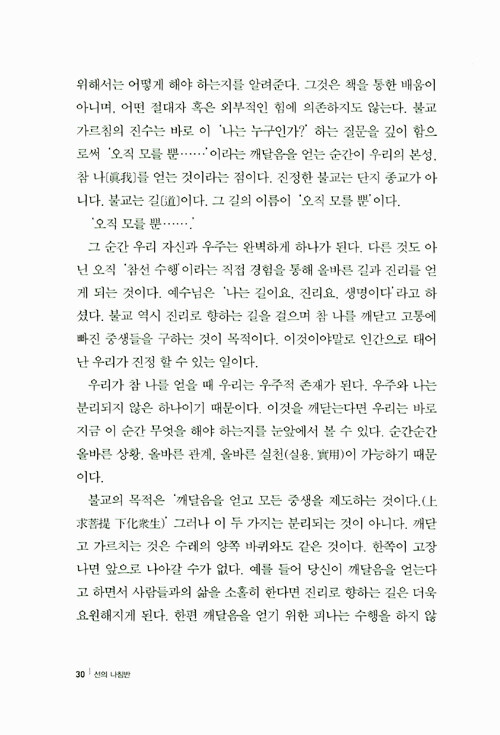

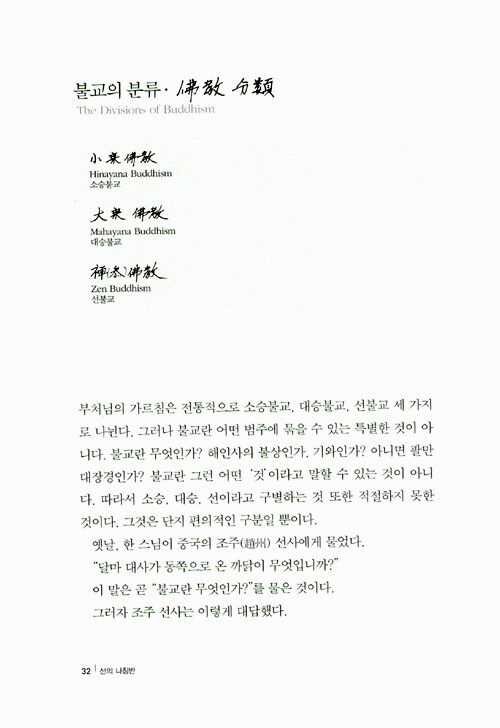
정가
18,000원
판매가
16,200원 (10%, 1,800원 할인)
마일리지
900원(5%) + 멤버십(3~1%)
+ 5만원이상 구매시 2,000원
세액절감액
730원 (도서구입비 소득공제 대상 및 조건 충족 시)
전자책
11,340원

배송료
무료
수령예상일
지금 택배로 주문하면 10월 4일 출고
최근 1주 91.4%
(중구 중림동 기준) 지역변경
종교일반 주간 13위, 종교/역학 top100 5주|
Sales Point : 1,620
이 책 어때요?
카드/간편결제 할인
무이자 할부
수량
장바구니 담기
바로구매
선물하기
보관함 +
중고 등록알림 신청
중고로 팔기

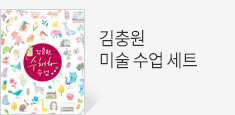
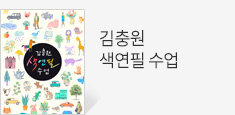
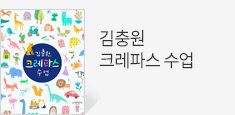

기본정보
양장본
484쪽
148*210mm
678g
ISBN : 9788934939474
주제 분류
신간알림 신청
국내도서 > 종교/역학 > 불교 > 불교 문학
국내도서 > 에세이 > 외국에세이
국내도서 > 에세이 > 종교에세이 > 불교
국내도서 > 종교/역학 > 불교 > 불교 인물
국내도서 > 종교/역학 > 종교일반 > 종교인물
책소개
진리의 안내자 숭산 대선사의 30여 년간의 설법을 제자 현각 스님이 집대성한 지혜와 깨달음의 정수! 따뜻하고 자애로우면서도 격식에 구애받지 않는 숭산 스님의 파격적인 법문은 딱딱한 불교가 아닌, 재미있고 쉬운 불교로 우리를 안내한다.
참나를 깨닫고 중생을 교화하는 불교의 목적에서부터, 소승불교, 대승불교, 선불교로 이어지는 부처님의 가르침까지! 쉽고 재미있게, 그러나 핵심을 관통하는 숭산 스님의 말씀은 연기법과 삼법인, 사성제와 팔정도, 육바라밀행 등 불교교리의 핵심 가르침을 설명하고, 금강경, 반야심경, 법화경, 화엄경 등 경전에 담긴 불법의 세계를 경험하게 한다.
목차
우리는 지금 어디로 가고 있는가
1. 불교
불교의 목적
불교의 분류
불교의 구성
2. 소승불교
소승불교
무상관
부정관
무아관
연기
십이연기
사성제
팔정도
삼법인
삼학
3. 대승불교
대승불교
금강경
반야심경
대열반경
법화경
화엄경
법성게
업과 윤회
카르마
육바라밀행
4. 선불교
선불교
선의 분류
최상승선
불립문자
교외별전
직지인심
견성성불
고칙공안
좌선
대오
참구법
선의 3요소
선 정진
선원
어떤 것이 불성인가
세 가지 물건
여여한 경지
돌이켜보라
인생 길
보는 자가 여래다
어느 곳으로 가는가
도솔삼관
있는 그대로 부처다
'오직 모를 뿐'으로 정진하라
10개의 공안
광우병과 나침반
옮긴이의 말
접기
책속에서
부처님은 본성을 찾는 것이 우리 삶에서 가장 중요하다는 것을 우리에게 가르쳐준 최초의 인물이다. ‘우리는 태어났을 때 어디서 왔는가, 죽으면 어디로 가는가. 올바른 삶이란 과연 무엇인가.’ 많은 사람들은 ‘당신이 누구인가?’ 하는 질문을 받으면 이렇게 대답한다. 변호사, 의사, 택시 기사, 학생 혹은 누구누구의 남편, 아내, 딸, 아들…… 그러나 이 모든 것들은 우리 바깥의 모습일 뿐이다.
이제 우리 내면으로 눈을 돌려야 한다. 그리하여 참 삶을 살아야 한다. 진정한 삶이란 바로 대자대비의 삶이다. 자신뿐만 아니라 다른 중생들까지도 고통으로부터 구해내는 것이다. 그것을 위해서는 우리 자신부터 먼저 고통에서 벗어나야 한다. 이것이 우리가 본성을 찾아야 하는 이유이다.
죽기 전에 우리는 그것을 알아야 한다. 그렇다면 우리의 삶은 올바른 삶이 될 수 있다. 이것은 책에서 찾아질 수 있는 것이 아니다. 아무리 공부를 많이 한 박사라도 우리 자신의 본성을 모른다면 소용이 없다. 본성을 찾기 위한 가장 좋은 방법은 참선 수행이다.
바른 수행은 우리 자신을 이해하는 일에서부터 시작한다. ‘나는 누구인가?’라고 묻는 것이 참선 수행의 시작이자 끝이다. 이 질문을 깊이 하게 되면 모든 생각이 끊어지고 생각 이전의 상태로 돌아오게 된다. 그리하여 ‘오직 모를 뿐’을 깨달아 우리 자신을 알게 되는 것이다. 우리의 본래 모습이란 바로 이러한 생각이 일어나기 전의 마음 상태를 말한다. 이런 상태라야만 우리는 우리 자신을 찾을 수 있고 다른 중생들을 고통에서 구해낼 수 있다. 그것이 바로 ‘눈뜸’이다.
이 책의 제목을 왜 ‘선의 나침반’이라고 지었는가? 부처님은 우리 인생이 ‘고해(苦海)’라고 가르쳤다. 모든 사람들은 나고 늙고 병들어 죽는다. 그리고 또 다시 태어나고, 우리의 욕망과 집착 때문에 우리는 고해에 빠지기를 반복한다. 산스크리트로 이것을 ‘삼사라(samsara, 輪回)’라고 부른다. 돌고 돌고 돈다는 뜻이다. 부처님은 우리가 이 고통의 바다를 건너기 위해 ‘지혜(prajna)의 배’가 있어야 한다고 했다. 그리고 이 배에는 다른 배들과 마찬가지로 나침반이 필요하다. _저자의 말 중에서 접기
‘오직 모를 뿐…….’
그 순간 우리 자신과 우주는 완벽하게 하나가 된다. 다른 것도 아닌 오직 ‘참선 수행’이라는 직접 경험을 통해 올바른 길과 진리를 얻게 되는 것이다. 예수님은 ‘나는 길이요, 진리요, 생명이다’라고 하셨다. 불교 역시 진리로 향하는 길을 걸으며 참 나를 깨닫고 고통에 빠진 중생들을 구하는 것이 목적이다. 이것이야말로 인간으로 태어난 우리가 진정 할 수 있는 일이다.
우리가 참 나를 얻을 때 우리는 우주적 존재가 된다. 우주와 나는 분리되지 않은 하나이기 때문이다. 이것을 깨닫는다면 우리는 바로 지금 이 순간 무엇을 해야 하는지를 눈앞에서 볼 수 있다. 순간순간 올바른 상황, 올바른 관계, 올바른 실천(실용, 實用)이 가능하기 때문이다.
불교의 목적은 ‘깨달음을 얻고 모든 중생을 제도하는 것이다.(上求菩提 下化衆生)’ 그러나 이 두 가지는 분리되는 것이 아니다. 깨닫고 가르치는 것은 수레의 양쪽 바퀴와도 같은 것이다. 한쪽이 고장나면 앞으로 나아갈 수가 없다. 예를 들어 당신이 깨달음을 얻는다고 하면서 사람들과의 삶을 소홀히 한다면 진리로 향하는 길은 더욱 요원해지게 된다. 한편 깨달음을 얻기 위한 피나는 수행을 하지 않는다면 또한 부처가 될 수 없다.
깨달음을 얻고 중생을 제도하는 두 가지 수레바퀴로 나아갈 때, 우리는 불국토의 나라에 도달할 수 있는 것이다. 아무리 8만 4천 경전이나 성경을 줄줄이 왼다 하더라도 나 자신을 찾지 못한다면 중생을 제도할 수 없으며, 그 모든 이해와 지식은 무용지물이 되는 것이다. 박사학위를 몇 개씩 가지고 있는 사람이라 할지라도 정작 눈감고 죽는 순간에 그것이 무슨 도움이 된단 말인가. _본문 중에서 접기
《반야심경》의 ‘색즉시공 공즉시색’은 진실을 그대로 ‘반영’하고 있다. 하늘은 푸르다. 나무는 초록색이다. 벽은 하얗다. 밖에 개가 짖는다. 우리 마음은 크고 둥근 거울 같다. 오로지 비추고 비추고 비추기만 한다. 모든 것이 있는 그대로 진리, 즉 여여(如如, truth like-this)이다.
그러나 진리를 반영하는 것만으로는 세상을 도울 수 없다. 물론 우주처럼 맑은 거울 같은 마음을 가져 이 세계를 있는 그대로 비춰야 한다. 깨끗한 거울 같은 마음에 붉은 공을 비추면 붉은 것이 비춰진다. 하얀 공을 비추면 하얀 것이 비춰진다. 그러나 이것으로는 충분치 않다. 만약 배고픈 사람이 내 앞에 나타났을 때 단지 같이 배고파하면 되는가. 슬픈 사람이 나타났을 때 그저 같이 슬퍼하면 되는가. 단순히 진리를 비추는 것만으로는 이들을 도와주지 못한다. 좀더 완벽한 답이 필요하다. _본문 중에서 접기
추천글
이 책을 추천한 다른 분들 :
한겨레 신문
- 한겨레 신문 2010년 5월 15일 지성 새책
저자 및 역자소개
숭산 (지은이)
숭산 큰스님은 서양에서 가르침을 편 독보적인 한국 선사다. 1927년 평안남도 순천 태생으로 장로교 계통의 기독교 가정에서 태어났으며, 일제시대에 독립운동 단체에 가담하여 활동하다 체포되어 옥고를 치르기도 했다. 동국대학교에서 공부를 하던 중, 참된 진리를 구하기 위해 1947년에 충남 마곡사로 출가하였고 행원(行願)이라는 법명을 받았다. 1949년 당시 한국 불교의 대표적 선지식이었던 고봉 대선사로부터 전법게(傳法偈)와 숭산(崇山)이라는 당호(幢號)를 받아 이 법맥의 78대 조사(祖師)가 되었다.
1966년 일본 도쿄에 홍법원을 세우는 것으로 첫 해외 포교가 시작되었다. 이후 1969년에 홍콩에 선원을 설립하였고, 1972년 영어 한마디 모른 채 미국행 비행기를 탔다. 큰스님은 일부러 한국 사람들이 없는 곳에 정착해 사람들을 가르치기 시작했다. 당시 프로비던스의 브라운대학을 비롯하여, 하버드대학과 예일대학 등 여러 대학에서 교수와 학생들이 찾아오기 시작했다. 큰스님은 모여드는 제자들을 위해 낮에는 세탁소에서 일하며 선원의 살림을 꾸려 나갔다. 이 책 《부처가 부처를 묻다(Dropping Ashes on the Buddha)》가 바로 이 시절의 큰스님 법문과 제자들과 나눈 문답, 서신 등을 엮은 것이다.
큰스님의 해외 포교는 1974년 캐나다 토론토 선원, 1978년 폴란드 선원, 1980년 영국 런던 선원, 1983년 브라질 상파울로 선원, 1985년 프랑스 파리 선원 개설로 이어졌다. 이로 인해 한국 불교가 세계 곳곳에 널리 퍼졌고, 많은 외국인들이 한국의 불교, 문화, 역사, 언어에 관심을 갖게 되었다. 1987년 큰스님의 지도 하에 제1차 ‘세계 일화대회(The Whole World Is a Single Flower)’가 개최되었고, 매 3년마다 전 세계의 사부대중이 참석한 가운데 각 국에서 개최된다.
전 세계 36개 국에 120여 개 선원(禪院)을 설립하신 숭산 큰스님은 2004년 11월 30일 서울 화계사에서 입적하였다.
접기
최근작 : <부처가 부처를 묻다>,<선의 나침반>,<천강에 비친 달> … 총 6종 (모두보기)
현각 (엮은이)
미국의 독실한 천주교 집안에서 태어났다. 예일대학교를 나와 하버드대학교 신학대학원에 재학 중이던 1990년 숭산 스님(1927~2004)을 만나 출가했다. 출가 이후 한국 선원에서 30여 차례에 걸쳐 안거했으며, 한국 불교를 세계에 알리는 데 앞장서 왔다. 화계사 국제선원장을 지내고, 2009년 독일 뮌헨에 불이선원(不二禪院)을 여는 등 유럽에 한국 불교를 전파하는데 힘써오고 있다. 대표 저서로 《만행-하버드에서 화계사까지》가 있다.
최근작 : <선의 나침반>,<부처를 쏴라>,<공부하다 죽어라> … 총 13종 (모두보기)
허문명 (옮긴이)
저자파일
최고의 작품 투표
신간알림 신청
논설위원. 사회부, 경제부, 문화부를 거쳐 오피니언팀장과 국제부장을 지냈다. 오피니언팀장으로 일할 때 ‘김지하와 그의 시대’ 시리즈를 연재해 책으로 묶었으며, 국제부장으로 재직하며 ‘수교 50년, 교류 2000년 한일, 새로운 이웃을 향해’ 시리즈의 현장 취재를 기획·연재했다.
사실 우리 사회가 이념적으로 대립하고 네 편, 내 편으로 갈라져 잘 통합되지 않는 이유는 근본적으로 분단(전쟁을 포함해서) 때문이라고 생각한다. 그러나 이제 ‘통일 한국’을 향해 나아가야 할 시점에서 통합된 역사관을 정립해 우리 아이들에게 가르쳐야 하는 절실함이 있다. 그런 때가 빨리 왔으면 하는 바람으로 <김지하와 그의 시대>를 집필했다. 불교에 관심이 많아 <만행, 하버드에서 화계사까지> <삶의 나침반 1,2>를 펴냈으며, 번역서로 <선의 나침반> 등이 있다. 접기
최근작 : <한국의 일본, 일본의 한국>,<김지하와 그의 시대>,<여성이여 세상의 멘토가 되라> … 총 14종 (모두보기)
허문명(옮긴이)의 말
큰스님의 쉽고 친절하면서도 직접적인 설명은, 불교 공부가 어려운 한자로 가득한 경전 공부가 아니라 참선 수행이라는 마음 공부를 통해 삶을 혁명적으로 아름답게 바꾸는, 그리하여 다른 사람에게 도움이 되는 삶을 살 수 있게 하는 길잡이라는 것을 깨닫게 해주었다.
출판사 소개
김영사
도서 모두보기
신간알림 신청

최근작 : <햅틱스>,<물질의 물리학>,<문장의 시대, 시대의 문장>등 총 1,256종
대표분야 : 요리만화 1위 (브랜드 지수 360,088점), 사회/역사/철학 1위 (브랜드 지수 701,611점), 과학 2위 (브랜드 지수 439,913점)
북플 bookple
이 책의 마니아가 남긴 글
친구가 남긴 글
내가 남긴 글
친구가 남긴 글이 아직 없습니다.
마니아
읽고 싶어요 (9)
읽고 있어요 (3)
읽었어요 (26)
이 책 어때요?
구매자
분포

1.0% 10대

0.8%

5.6% 20대

6.6%

13.1% 30대

12.0%

17.4% 40대

17.1%

8.4% 50대

13.7%

1.3% 60대

3.0%
여성 남성
평점
분포
8.3

50.0%

33.3%

0%

16.7%

0%
100자평
등록
카테고리
글 작성 유의사항
구매자 (1)
전체 (4)
공감순

영문판을 한글판으로 옮기며 주객이 바뀐 책, 하버드 출신에 대한 집착을 버려야
마그리트 2010-06-22 공감 (2) 댓글 (0)
Thanks to
공감
마이리뷰
구매자 (0)
전체 (2)
리뷰쓰기
공감순

선(禪)의 나침반-숭산 지음, 현각 엮음
온전히 현각스님의 책인 줄 알았는데 "숭산 지음, 현각 엮음"이었다.
숭산스님이 교사였다면 분명 일목요연 아주 잘 가르치는 선생님이었지 싶다.
불교의 목적 : 상구보리 하화중생(上求菩提 下化衆生)
불교의 분류 : 소승불교, 대승불교, 선(禪)불교
불교의 구성 : 불(佛), 법(法), 승(僧)
불교의 목적, 분류, 구성이라는 큰 테두리의 설명으로 시작해서 각각 부분으로의 세부적인
설명이 이어진다. 불교를 처음 접하는 사람들이 읽는다면 상당히 훌륭한 교과서적 역할을
할 수 있을 것 같다.
<왜 인구가 갑자기 늘어나는 것일까?
그에 따른 결과는 무엇일까?
시간이 흐를수록 사람들은 왜 더욱더 고통에 시달리며,
그 고통의 양은 매일매일 늘어만 가는 것일까?
여러 가지 이유를 들수있겠지만 가장 중요한 것은
요즘 인간들이 고기를 너무 많이 먹고 싶어하기 때문이다.
(...)
20세기에 들어오면서 동물을 한꺼번에 죽일 수 있는 특별한 도구들이 나오기 시작햇다.
수백, 수천만 동물들이 단지 인간의 욕망을 채워주기 위한 수단으로 전세계에서 매일
도살되고 있다.
(...)
인간과 동물은 서로 많은 차이를 갖고있으므로 섞여 있으면 좋지 않다
동물들은 오직 자기들의 종족 번식을 위해서만 살지,
다은 종과는 어울리려고 하지 않는다.
(...)
그들은 자기 종들끼리만 몰려 다니고
다른 종이 공격해 오면 떼거지로 반격한다.
바로 그것이 동물의 세계인 것이다.
인간 세계도 이와 비슷해지고 있다.
(...)
자기 엄마가 아프다는 소리에는 꿈쩍도 안 하던 그녀가
기르던 고양이가 아프다니까 안절부절 못하는 것이었다.
그녀는 자기를 낳아준 엄마보다 고양이를 더 사랑했던 것이다.
그녀의 얼굴과 몸은 비록 인간이었다 할지라도
의식의 일부는 이미 동물이 돼 있었던 것이다.
그러다 보니 정작 사람들과의 관계는 서툰 대신
고양이와는 아주 쉽게 동화될 수 있었던 것이다.>
책의 말머리에 나오는 이 글들을 보고 참으로 공감했다.
잔디조차 산 생물이라 밟지 못하며, 바퀴벌레 한 마리도 죽이지 못하는 사람이 육식을 아주
즐긴다는 말에 실소를 금할 수 없었는데... 우리는 때로 자신의 가치관들이 추호의 의심없이
옳다고 여기는 것들이 있지만, 다른이들의 눈에는 다르게 보일 수도 있다는 것을 염두에
두어야 할 것 같다.
숭산 스님과 현각 스님을 보며, 훌륭한 스승을 만난다는 것은 참으로 복된 일이란 생각에,
그 스승을 따라 들어 온 나라를 등져야 하는 그 마음은 얼마나 참담할까 싶어 무척 안타깝지만,
현각 스님께 훌륭한 스승이 계시었 듯, 그 또한 어디서든 훌륭한 스승으로 자리하실 것을
믿어 의심치 않으며 이 책을 기분 좋게 덮는다.
*그는 무지가 나타날 때 '마음'이 나타남을 깨달았다. 또 마음이 나타나면 욕망이 일어난다는
것도 깨달았다. 그 욕망에서 삶과 죽음, 오고 감, 행복과 불행 등이 생겨나는 것을 보았다.
오로지 '오직 모를 뿐' 하는 마음을 온전히 지켜감으로써 부처님은 이 끝없는 윤회의 사슬을
어떻게 끊을 수 있는지를 깨달은 것이다.
*불교의 가르침의 진수는 바로 이 '나는 누구인가?' 하는 질문을 깊이 함으로써 '오직 모를 뿐..
....' 이라는 깨달음을 얻는 순간이 우리의 본성, 참 나(眞我)를 얻는 것이라는 점이다.
진정한 불교는 단지 종교가 아니다. 불교는 길(道)이다. 그 길의 이름이 '오직 모를 뿐'이다.
'오직 모를 뿐......'
그 순간 우리 자신과 우주는 완벽하게 하나가 된다. 다른 것도 아닌 오직 '참선 수행'이라는
직접 경험을 통해 올바른 길과 진리를 얻게 되는 것이다.
*소승불교는 우리가 살고 있는 이 인생이 덧없는 고통의 바다임을 먼저 강조한다. 그러나 사실
그 고통의 세계는 전적으로 우리의 '생각'이 만들어낸 것이며, 일단 생각이 일어나면 삶과 죽음
이라는 상대적 세계가 나온다. 결국 고통에서 벗어나려면 생각을 끊어 상대적 세계에서 영원
불멸의 절대적 세계, 즉 열반을 얻어야 한다.
(...) 이에 비해 대승불교는 공(空), 즉 본래 이 '나'라는 것은 없다는 소승불교의 가르침이
끝나는 지점에서 곧바로 시작한다. 소승불교가 '모든 것이 고통'이라는 인식에서 출발해 공,
열반의 세계에서 끝난다면 대승불교는 소승불교의 종착점인 공에서 출발한다.
모든 것이 공하다는 것은 다시 말해 있는 그대로 '완전하다'는 것을 말한다.
(...) 대승불교는 모든 것이 공하다는 깨달음에서 출발하여 있는 그대로인 진리를 보고 그런
다음 이생에서 다음 생, 또 다음 생, ..... 계속 삶을 이어가는 동안 어떻게 괴로움에 빠진 중생을
도우며 살 것인가에 대한 가르침이다. 이것이 바로 대자대비의 삶이다. 순간순간 내 삶은 오로지
중생들을 위해 있을 뿐이다.
그렇다면 선(禪)불교는 무엇인가?
선은 결코 절대니, 상대니 하는 것을 운운하지 않는다. 허무의 세계니. 진리의 세계니, 완전한
세계니 하는 식으로 설명하지 않는다. 선 수행은 무엇을 설명하는 것이 아니다. 바로 직접적으
로 마음을 탐구해 깨달음을 얻어 중생을 돕는 것이다. 그렇기 때문에 언어을 통한 배움에 강조
를 두지 않는다. 단지 수행만이 있을 뿐이다. 선 수행은 바로 이 순간 '마음'을 들여다보는 것
이다. 나는 지금 무엇을 하고 있는가? 나의 마음은 어디에 머물고 있는가? 선의 가르침은 항상
우리가 '순간의 세계(moment world)'라고 부르는 곳으로 돌아온다. 한 순간이 전부이다. 한 순
간 안에 모든 것이 있다. <탕!(죽비 치는 소리)>
*진정한 마음은 '움직이지 않는 마음'에서 오는 것이다. '사마디', 즉 '삼매'라고 부른다.
우리의 본성, 혹은 흔들리지 않는 마음이란 뜻이다. 마음이 흔들리지 않으면 모든 것은 있는
그대로 아름답다.
*불법승은 본래 사람들의 깨끗한 마음에서 나왔다. 우리의 순수한 마음이 불(佛)이고, 우리
마음이 순간순간 맑게 빛난다면 그것이 법(法)이다. 또 우리 마음이 어떤 상황에서도 걸림이
없다면 그것이 승(僧)이다. 다시 말해 불은 순수한 마음이고, 법은 맑은 마음이며, 승은 순간
순간, 걸림 없이 모든 중생들을 돕겠다는 행동이다. 삼보는 이처럼 하나이다. 이를 일체삼보
(一切三寶)라고 부른다. (...) 맑고 깨끗하고 걱정 없는 마음으로 차를 마신다면 바로 그 순간
우리는 불법승이 된다. (...) 이것이 '평상심'이다.
*불교는 어떤 원죄 의식도 요구하지 않는다. 모든 것은 공(空)이므로 우리의 업도 공하다.
'원죄'란 공이 아니라 '어떤 것'이다. 부처님의 가르침은 타고난 우리의 본성에 초점이 맞춰져
있다. 따라서 진정한 선의는 옳은 방향을 말하는 것이고, 이것을 경험하는 방법은 부처님의
계를 실천함으로써 가능하다.
*돈이 주는 진짜 즐거움은 그것을 바르게 썼을 때뿐이다. 죽을 때 돈은 아무 소용이 없다.
우리의 욕심을 채우기 위해서만 돈을 쫓는다면 이런 생각의 에너지가 우리 마음에 독이 될
뿐만 아니라 고통이 뒤따르게 되는 것이다. 그래서 우리는 탐욕을 더러움이라고 하는 것이다.
*무언가 하고 싶으면 이런 질문을 항상 염두에 두어야 한다. '왜 내가 이것을 하지?' 이것이
바로 정견(正見)이다.
*'정업(正業)'은 언제나 우리의 행위가 다른 사람에게 어떤 영향을 미칠지 생각하는 것이다.
그것이 곧 우리 마음에 영향을 미치기 때문이다. 정업을 '바른 업'이라고 하는 이유가 여기에
있다.
*정명(正命), 이는 우리의 생계, 직업, 일과 관계되는 부분이다. 모든 사람은 안과 밖 두 가지
일을 가지고 있다. 안으로는 맑은 마음을 유지하는 것이고, 밖으로는 이기심을 버리고 남을
도와주는 일이다.
*참된 수행, 다시 말해 정정(正定)이란 어떤 몸의 자세가 아니라는 것이다. 어떻게 순간순간
매일 일상의 한가운데서 나의 맑은 마음을 유지하는가 하는 것이다.
*우주 만물의 모든 것은 변한다. (...) 결코 변하지 않는 것, 오고 가지 않는 것이 있는데, 이것이
바로 본성이다. 그것은 어떤 '것'이 아니다. 이것을 진정으로 경험하기 위해서는 먼저 모든 사물
과 마음의 모든 것이 조건에서 나오고 결국 무상하다는 것을 깨달아야 한다. 이런 경험을 한 번
이라도 제대로 한다면 결코 잊어버리지 않을 것이고 도장처럼 박힐 것이다.
*생각을 하면 어디에서도 참 마음을 발견할 수 없다. 모든 생각을 끊으면, 모든 집착을 끊으면
우리의 참 자아는 어디든 나타난다.
*누군가 목이 마르다고 하면 물을 주고, 배가 고프다고 하면 빵을 주면 된다. 단지 '......할' 뿐
이다. 우리 앞에 고통으로 신음하는 사람이 있으면 아무 생각 없이 단지 도우면 된다. 단지 하면
되는 것이다.
*어떻게 우리의 생각에서 벗어날 수 있는가? 어떻게 공의 마음을 유지할 것인가? (...) 단지 하나
의 마음을 가지면 된다. 뭔가를 할 때 그냥 하면 된다. 단지 그냥 하면 된다. 이 그냥 하는 마음
에는 주체도 없고 객체도 없다.
*뭔가 할 때 가장 중요한 것은 의심하지 않고 따지지 않고 100% 그냥 하는 것이다. 말은 중요
하지 않다. 깨달음을 얻고 싶으면 무엇보다 필요한 것이 노력하는 마음이다. 오직 노력하고 실
천하라. 그것이 가장 좋은 방법이다.
- 접기
Grace 2016-08-18 공감(4) 댓글(0)
Thanks to
공감
선종 불교로 직행하고 싶다면 바로 이 책이다.
말그대로 선종 불교로 안내하는 불교 입문서다. 독자에게 선종 불교를 소개하기 위해서 초기불교부터 선종불교까지의 개념을 설명하고 있다. 핵심 개념을 추려서 챕터로 삼고, 각 챕터마다 개념에 대한 설명과 구체적 사례를 들어서 설명하고 있다.
그런데 설명하는 방식이 다소 유쾌하다. 선종 불교 특유의 재치도 있지만, 도중에 문자를 뛰어넘지만 넘지 않는 표시들, "탕", "할", "하하하"가 많이 나온다. 만약 저자가 이모티콘을 알고 있었더라면, 이모티콘을 적극적으로 사용할 것이다. 처음에는 생소하지만, 읽을 수록 호탕한 대선사의 앞에서 설법을 받는 느낌이 든다.
하지만 이 책의 단점도 있다. 바로 관점이다. 초기불교와 대승불교의 개념에 대해 선불교적 관점으로 설명하고 있다는 것이다. 혹은 선불교 조차, 숭산 대선사의 관점에서 "오직 모를뿐" 관점으로 설명하고 있을 수도 있다. 불교를 "있는 그대로", "여여즉여"하게 이해하고 싶다면, 이 책 말고 다른 불교 교리서를 읽어보아야 할 것이다.
물론, 선불교 입장에서는 이 책도 방편일 뿐이다. 주관이든 객관이든, 실체, 실상, 실용만 깨우치면 무슨 상관이랴. 마지막 공안마저 읽고 나면, 언어의 무용을 깨달을 것이니. 이 책을 제대로 이해하였다면, 독자는 "평상심"이라는 언어를 얻게 될 것이다. 평상심을 얻기 위해서는 말과 책을 덮고 나와 세계를 읽을 준비를 해야 한다. 탕!













